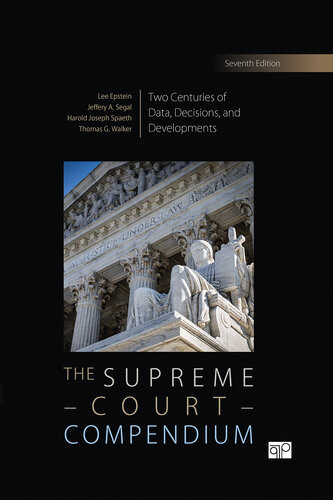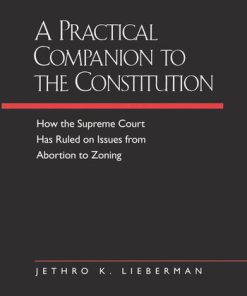The Supreme Court Compendium 7th Edition by Lee J Epstein, Jeffrey A Segal, Harold J Spaeth, Thomas G Walker ISBN 9781071834565 1071834568
$50.00 Original price was: $50.00.$25.00Current price is: $25.00.
The Supreme Court Compendium 7th Edition by Lee J Epstein, Jeffrey A Segal, Harold J Spaeth, Thomas G Walker – Ebook PDF Instant Download/Delivery: 9781071834565 ,1071834568
Full download The Supreme Court Compendium 7th Edition after payment

Product details:
ISBN 10: 1071834568
ISBN 13: 9781071834565
Author: Lee J Epstein, Jeffrey A Segal, Harold J Spaeth, Thomas G Walker
The Supreme Court Compendium 7th Edition Table of contents:
1 The Supreme Court: An Institutional Perspective
Table 1-1 Chronology of Important Events in the Supreme Court’s History, 1787–2020
Table 1-2 Brief Overview of the Supreme Court, 2021
Table 1-3 Select Congressional Legislation Relating to the Supreme Court
Table 1-4 Sections of the United States Code Pertaining to the Organization of the Supreme Court
Table 1-5 Sections of the United States Code Pertaining to the Jurisdiction of the Supreme Court
Table 1-6 Supreme Court Budget Appropriations, 1930–2021
Table 1-7 The Supreme Court’s Operational Budget, Fiscal Years 2019–2021
Table 1-8 Salaries of the Justices, 1789–2020
Analyzing the Salaries of the Justices: A Data Literacy Lesson
Table 1-9 Retirement and Pension Provisions for the Supreme Court Justices
Table 1-10 Outline of the Rules of the Supreme Court of the United States
Figure 1-1 The Processing of Supreme Court Cases
Table 1-11 The Supreme Court’s Calendar
Table 1-12 Sections of the United States Code Pertaining to Supreme Court Officers and Employees
Table 1-13 Supreme Court Employees: Full-time Permanent Positions, 1930–2021
Table 1-14 Administrative Officers of the Supreme Court, 1790–2021
2 The Supreme Court’s Review Process, Caseload, and Cases
Table 2-1 Supreme Court Rule 10: Considerations Governing Review on Certiorari
Table 2-2 The Supreme Court’s Caseload, 1880–2019 Terms
Table 2-3 Cases on the Dockets of the Supreme Court, 1935–1969 Terms
Table 2-4 Cases on the Dockets of the Supreme Court, 1970–2019 Terms
Table 2-5 Petitions Granted Review, 1926–1969 Terms
Table 2-6 Petitions Granted Review, 1970–2019 Terms
Table 2-7 Guide to Oral Argument at the Supreme Court
Table 2-8 Signed Opinions, Cases Disposed of by Signed Opinion, and Cases Disposed of by Per Curiam Opinion, 1926–2019 Terms
Table 2-9 Print Reporting Systems
Table 2-10 Where to Obtain Supreme Court Opinions
Table 2-11 Formally Decided Cases by Chief Justice Era, 1791–2019 Terms
Comparing Issues in Cases by Chief Justice Era: A Data Literacy Lesson
Table 2-12 Major Decisions of the Supreme Court: The New York Times Measure, 1937–2019 Terms
Table 2-13 Cases Incorporating Provisions of the Bill of Rights into the Due Process Clause of the Fourteenth Amendment
Table 2-14 Supreme Court Decisions Holding Acts of Congress Unconstitutional in Whole or in Part, 1791–2019 Terms
Table 2-15 Supreme Court Decisions Holding State Constitutional and Statutory Provisions and Municipal Ordinances Unconstitutional on Their Face or as Administered, 1791–2019 Terms
Table 2-16 Supreme Court Decisions Overruled by Subsequent Decisions, 1791–2019 Terms
3 The Supreme Court’s Opinion, Decision, and Outcome Trends
Table 3-1 Unanimous Decisions, 1791–2019 Terms
Table 3-2 Dissenting Opinions, 1791–2019 Terms
Table 3-3 Dissenting Votes, 1791–2019 Terms
Investigating Trends in Dissenting Votes: A Data Literacy Lesson
Table 3-4 Concurring Opinions, 1791–2019 Terms
Table 3-5 Concurring Votes, 1791–2019 Terms
Table 3-6 Cases Decided by a Closely Divided Vote, 1791–2019 Terms
Table 3-7 Cases Decided by a Judgment of the Court, 1791–2019 Terms
Table 3-8 Disposition of Cases, 1791–2019 Terms
Table 3-9 Ideological Direction of Court Decisions, by Issue Area and Chief Justice, 1791–2019 Terms
Table 3-10 Ideological Direction of Court Decisions, by Issue Area, 1791–2019 Terms
Table 3-11 Means and Medians Based on Votes, 1937–2019 Terms
Table 3-12 Means and Medians of Segal–Cover Scores, 1946–2019 Terms
Table 3-13 Martin and Quinn’s Estimated Locations of the Most Liberal, Median, and Most Conservative Ideal Points, 1937–2019 Terms
4 The Justices: Backgrounds, Nominations, and Confirmations
Table 4-1 The Justices of the United States Supreme Court
Table 4-2 Birth and Childhood Statistics for the Justices
Table 4-3 Family Background of the Justices
Table 4-4 Education and Legal Training of the Justices
Table 4-5 Marriages and Children of the Justices
Table 4-6 Private Practice and Law Professorships of the Justices
Table 4-7 Military Experience of the Justices
Table 4-8 Political Experience of the Justices
Table 4-9 Prior Judicial Experience of the Justices
Table 4-10 Summary of Background Characteristics of the Justices
Table 4-11 Personal Finances of the Justices, 2019
Table 4-12 Supreme Court Nominees
Exploring Age at the Time of Nomination: A Data Literacy Lesson
Table 4-13 Supreme Court Nominees and the Vacancies to Be Filled
Table 4-14 Senate Judiciary Committee Action on Supreme Court Nominees
Table 4-15 Senate Action on Supreme Court Nominees
Table 4-16 American Bar Association Rating of Supreme Court Nominees since 1956
Table 4-17 Confirmation Factors, 1937–2020
Table 4-18 Public Opinion: Respondents Supporting or Opposing Nominees for the Supreme Court
Table 4-19 Appointment Anomalies
5 The Justices: Post-Confirmation Activities and Departures from the Court
Table 5-1 Length of Service (Ranked)
Studying the Justices’ Length of Service: A Data Literacy Lesson
Table 5-2 Natural Courts
Table 5-3 Circuit Justice Assignments, 1802–1867
Table 5-4 Circuit Justice Assignments, 1867–2021
Table 5-5 Extrajudicial Activities while Sitting on the Court
Table 5-6 Impeachment Actions against Supreme Court Justices
Table 5-7 Departure from the Court
Table 5-8 Justices Rated “Great,” Selected Studies
Table 5-9 Post-Court Activities
Table 5-10 The Deaths of the Justices
Table 5-11 Locations of Justices’ Personal Papers
Table 5-12 Selected Books and Articles Written by the Justices
Table 5-13 Published Biographies of the Justices
6 The Justices: Oral Arguments, Votes, and Opinions
Table 6-1 Ideological Values of the Justices, 1937–2020
Table 6-2 Martin–Quinn Estimates of the Justices’ Ideology and the Median Justice, 1937–2019 Terms
Table 6-3 Number of Questions Asked, on Average, Per Case, by the Individual Justices during Oral Argument, 2010–2019 Terms
Table 6-4 Aggregate Liberal Voting of Justices, 1791–2020 Terms
Table 6-5 Liberal Voting of the Justices, by Term, 1800–2019 Terms
Table 6-6 Voting Interagreements among the Justices, the Marshall Court
Table 6-7 Voting Interagreements among the Justices, the Taney Court
Table 6-8 Voting Interagreements among the Justices, the Chase Court
Table 6-9 Voting Interagreements among the Justices, the Waite Court
Table 6-10 Voting Interagreements among the Justices, the Fuller Court
Table 6-11 Voting Interagreements among the Justices, the White Court
Table 6-12 Voting Interagreements among the Justices, the Taft Court
Table 6-13 Voting Interagreements among the Justices, the Hughes Court
Table 6-14 Voting Interagreements among the Justices, the Stone Court
Table 6-15 Voting Interagreements among the Justices, the Vinson Court
Table 6-16 Voting Interagreements among the Justices, the Warren Court
Table 6-17 Voting Interagreements among the Justices, the Burger Court
Table 6-18 Voting Interagreements among the Justices, the Rehnquist Court
Table 6-19 Voting Interagreements among the Justices, the Roberts Court
Table 6-20 Proportion of Votes in the Majority in Decisions Declaring Legislation Unconstitutional, 1791–2019 Terms
Table 6-21 Proportion of Votes in the Majority in Decisions Formally Altering Precedent, 1791–2019 Terms
Table 6-22 Opinions of the Court, Dissenting Opinions, and Concurring Opinions, 1791–2019 Terms
Identifying Patterns in the Justices’ Opinion Writing: A Data Literacy Lesson
Table 6-23 Votes of the Justices, 1791–2019 Terms
Table 6-24 Solo Dissents, 1791–2019 Terms
7 The Supreme Court: Its Political and Legal Environments
Table 7-1 Amendments to the U.S. Constitution Overturning Supreme Court Decisions
Table 7-2 Most Litigated Federal Laws, by Chief Justice Era, 1801–2019 Terms (Marshall to Roberts)
Table 7-3 Most Litigated Constitutional Provisions, by Chief Justice Era, 1801–2019 Terms (Marshall to Roberts)
Table 7-4 Chairs of the Senate Committee on the Judiciary
Table 7-5 Chairs of the House Committee on the Judiciary
Table 7-6 Impeachment of Federal Judges and Justices
Figure 7-1 Organizational Chart of the Department of Justice
Table 7-7 Attorneys General of the United States
Figure 7-2 Organizational Chart of the Office of the Solicitor General
Table 7-8 Solicitors General of the United States
Table 7-9 Success Rate of the United States as a Party to a Case before the Supreme Court, 1791–2019 Terms
Table 7-10 Success Rate of the United States as a Party to a Case before the Supreme Court, by Issue Area and Chief Justice, 1800–2019 Terms (Marshall to Roberts)
Analyzing the Success of the U.S. Government in the Supreme Court: A Data Literacy Lesson
Table 7-11 Position Taken by the Solicitor General as an Amicus Curiae in Cases before the Supreme Court, 1946–2019
Table 7-12 Success Rate of the Solicitor General as an Amicus Curiae in Cases before the Supreme Court, 1946–2019 Terms
Table 7-13 Success Rate of Federal Agencies as a Party to a Case before the Supreme Court, 1860–2019 Terms
Table 7-14 Success Rate of Federal Agencies as a Party to a Case before the Supreme Court, by Issue Area, 1860–2019 Terms
Table 7-15 Success Rate of Federal Agencies as a Party to a Case before the Supreme Court, by Agency, 1860–2019 Terms
Table 7-16 Success Rate of States as a Party to a Case before the Supreme Court, 1850–2019 Terms
Table 7-17 Success Rate of States as a Party to a Case before the Supreme Court, by Issue Area and Chief Justice, 1837–2019 Terms (Taney to Roberts)
Table 7-18 Success Rates of States as a Party to a Case before the Supreme Court, by State, 1791–2019 Terms
Table 7-19 Supreme Court Rule 37: Brief for Amicus Curiae
Table 7-20 Supreme Court Cases Containing At Least One Amicus Curiae Brief, 1946–2019 Terms
Figure 7-3 The American Court System
Figure 7-4 The Federal Court System: United States Courts of Appeals and United States District Courts
Table 7-21 The Development of the U.S. Courts of Appeals
Table 7-22 U.S. Court of Appeals Decisions Reversed by the Supreme Court, 1891–2019 Terms
Table 7-23 Article I Special Jurisdiction Courts
Table 7-24 Article III Special Jurisdiction Courts
Table 7-25 Specialized Court Decisions Reversed, 1791–2019
Table 7-26 State and Territorial Court Decisions Reversed by Chief Justice Era, 1801–2019 Terms (Marshall to Roberts)
8 The Supreme Court and Public Opinion
Table 8-1 Respondents Allowing Atheists to Perform Specified Activity (Percentage)
Table 8-2 Respondents Allowing Racists to Perform Specified Activity (Percentage)
Table 8-3 Respondents Allowing Gays to Perform Specified Activity (Percentage)
Table 8-4 Respondents Allowing Communists to Perform Specified Activity (Percentage)
Table 8-5 Respondents Allowing Militarists to Perform Specified Activity (Percentage)
Table 8-6 Respondents Favoring Capital Punishment, Various Polls (Percentage)
Table 8-7 Respondents Believing Courts Not Harsh Enough with Criminals (Percentage)
Table 8-8 Respondents Approving of Brown v. Board of Education
Table 8-9 Respondents Disapproving of Racial Intermarriage and Approving of Segregated Neighborhoods (Percentage)
Table 8-10 Respondents Approving of Busing, Various Polls (Percentage)
Table 8-11 Respondents Favoring or Opposing Affirmative Action (Percentage)
Table 8-12 Respondents Believing a Woman’s Job Is to Take Care of the Home
Table 8-13 Respondents Believing Information on Birth Control Should Be Legally Available, Select Polls (Percentage)
Table 8-14 Respondents Believing Birth Control Should Be Available to Minors
Table 8-15 Respondents Supporting Roe v. Wade, Select Polls (Percentage)
Table 8-16 Respondents Believing Abortion Should Be Legal Under Any Circumstances, Legal Only in Certain Circumstances, or Illegal in All Circumstances (Percentage)
Table 8-17 Respondents Supporting Legal Abortion under Special Circumstances (Percentage)
Table 8-18 Respondents Believing Gay Sex Is Wrong
Table 8-19 Respondents’ Views on Same-Sex Marriage (Percentage)
Table 8-20 Respondents Approving of Supreme Court Decisions Preventing Organized Prayer or Bible Readings in Schools, Select Polls (Percentage)
Table 8-21 Respondents Believing Gun Laws Should be More Strict, Less Strict, or Kept As They are Now (Percentage)
Table 8-22 Respondents Supporting an Individual’s Right to Die, Various Polls (Percentage)
Table 8-23 Respondents Having a Great Deal of Confidence in the Supreme Court, Congress, and the Executive Branch of the Federal Government (Percentage)
Table 8-24 Respondents Having a Great Deal or Quite A Lot of Confidence in the Supreme Court, Congress, and the Presidency (Percentage)
Exploring Public Confidence in the Supreme Court: A Data Literacy Lesson
Table 8-25 Respondents Believing the Supreme Court Is Too Liberal, Too Conservative, or About Right (Percentage)
Table 8-26 Respondents’ Impressions of the Justices, 2019 (Percentage)
Table 8-27 Public Reaction to Franklin D. Roosevelt’s Plan to Enlarge the Supreme Court (Percentage)
Table 8-28 Members of State, District, and Territorial Bars Favoring Franklin D. Roosevelt’s Plan to Enlarge the Supreme Court (1937)
Table 8-29 Respondents Believing That the Supreme Court’s Decision in Bush v. Gore Mainly Reflected the Political Views or Partisan Politics of the Justices (Percentage)
Table 8-30 Respondents Approving of or Agreeing with the Supreme Court’s Decision in Bush v. Gore (Percentage)
Index
People also search for The Supreme Court Compendium 7th Edition:
x-citement video supreme court
expand the supreme court 2022
expand supreme.court
supreme court cases volume 1
amendment v supreme court cases
Tags: Lee J Epstein, Jeffrey A Segal, Harold J Spaeth, Thomas G Walker, Supreme Court Compendium
You may also like…
Jurisprudence & Law - General & Miscellaneous Law
The U.S. Supreme Court: A Very Short Introduction 2nd Edition Linda Greenhouse
Science Fiction - Fantasy Fiction
A Court of Frost and Starlight Court of Thorns and Roses 4 Sarah J. Maas
Jurisprudence & Law - Constitutional Law
Uncategorized
The Supreme Court and McCarthy Era Repression One Hundred Decisions 1st Edition Robert M Lichtman
Jurisprudence & Law - Courts & Trial Practice











